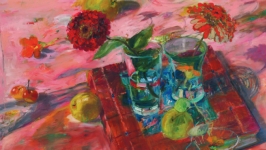Objets D'art: The Story Behind a Beloved Vase
To be clear, I love the pitcher. The glass shines in the sun. It has tall lines, a wide mouth and a curved lip that calls for a bouquet of heavy-headed roses. Or fresh-squeezed orange juice on a Sunday morning.
I’ll confess now that I am allergic to roses and I don’t like pulp.
But I still love the pitcher, with its thick, intricately stamped glass, given to me by an aunt who inherited it from my grandmother. I’ll never know why this particular pitcher appealed to my grandmother, but I’m curious about why, with its busy surface, it appeals so much to me.
I was googling cake plates recently and came across the Ohio-based Mosser Glass Co. The family-owned-and-operated glass factory has been pressing plates, bowls, platters, pitchers and more for more than 40 years. And their pitchers looked familiar. There, I thought, I might find the origin of my grandmother’s pitcher. Maybe even the story behind the mold. So on the first warm day of spring, my pitcher and I took a road trip to Guernsey County.
Snug between two hills of the Appalachian plateau sits both the Mosser Glass Co. and Factory. The store resembles a home: Vintage tables and breakfronts hold stacks of clear, colored glass or milk glass in robin’s egg blue, buttercream, black raspberry, marble and milk. Jade, with its midcentury modern appeal, has long been Mosser’s bestseller.
Some shapes are modern and smooth, like the cake stand you see here. Others are more ornate, like the textured cake plate that I watched being pressed later that day. All are glossy, gleaming with the saturated color that is particular to milk glass or the clarity of flawless, fresh-pressed glass.
Adding to the store’s inviting feel is the fact that the first three people I meet are family. Mosser is second-generation family-owned, shared between Tim, Sally and Mindy Mosser. On the day I visited, Sally, Mindy and Sally’s adult daughter, Jennifer, were running the store. Mindy’s teenage son spends summers in the factory. As Mindy tells me, “We are proud to be family-owned and producing quality American-made products.”
Their father, Tom Mosser, worked as a teenager for Cambridge Glass, where his father, Orie, was plant manager. The plant closed, but young Tom was hooked. He spent the next few years saving to buy molds—a glass maker’s intellectual property—and materials to create his own press. Working first from a chicken coop, Tom pressed pharmaceutical wares like mortars, pestles and beakers. In 1971, Tom moved to Mosser’s current location and expanded his product line to include new designs as well as classic molds from Viking, L.G. Wright and his former employer, Cambridge Glass. Mosser Glass was born.
Today, Tom’s early pharmaceutical pieces are displayed in a china cabinet at the factory entrance. Above the cabinet are the glass maker’s raw materials: Jars of pigment and the soda and silica ash that turn to molten glass when heated to 2,500°.
To deal with such heat, the factory is open-air. Large, unscreened windows reveal sky and a forest of budding trees. Inside, three to 12 workers run each of the three furnaces, depending on the product. Each employee knows his place and stays out of the others’ way. What I observe is akin to a dance rehearsal, all muscle and motion, codependence, focus and frustration: the silence occasionally punctured by laughter or a clear directive. Every piece produced here is a challenge, vulnerable to both human and material error. A checker examines the glass as it emerges hot from the mold, looking for any major stones, cracks or pattern or shape flaws. A perfect piece is then glazed for color or slowly cooled over three and a half hours to prevent cracking. If it’s flawed, it’s dumped into a wheelbarrow to be ground down and recast. On a good day, 5% are rejected. On a bad, that number can hit 50.
During my visit, a “gatherer” worked by sight and feel to repeatedly pull just the right amount of red-hot glass from the fire to make a candy dish. Later, I lay my palm against a cake plate as it came off the cooling belt. The heat was almost human.
As for my pitcher? Not Mosser, but close. Tim Mosser identified it via email as Cambridge Glass. In a sense, I did visit its place of origin.
Years ago, my college roommate and I exchanged almost identical Christmas gifts: squat, curvy vases. We laughed, loving proof that we were simpatico and then she said, soberly, “I guess our aesthetic has changed.” We laughed again, less freely this time, because what we were really saying was that we had changed. Six months of eating our way through Paris—no crêperie left untried—had changed our bodies and that had changed the look of our chosen objets. We liked things chubby during that season of our lives.
My roommate’s theory was that we pick things that remind us of ourselves. Look around and see if that doesn’t hold true for you. What you surround yourself with speaks to who you are, or perhaps more tellingly, who you want to be. My grandmother’s pitcher always seemed too busy, too solid, and just not elegant. Which says more, of course, about how I want to see myself.
Today the pitcher is being used as a vase. It sits on the kitchen table filled with flowers that I never would have picked, but my daughter did. It’s smudged thanks to my baby’s new ability to grab. It’s not smooth, streamlined or new. But the pitcher wears its age well. It looks happy.
Remembering the heat of the glass at Mosser, I think of it as having life. Life that, when I stop resisting, looks a lot like mine.





